A Comprehensive Review of Transportation and Logistic Management
VerifiedAdded on 2023/04/23
|9
|2041
|363
Literature Review
AI Summary
This literature review provides an overview of key aspects in transportation and logistics management, focusing on customer service and supply chain strategies. It examines the impact of the Great Recession on logistics and transportation, emphasizing the need for companies to understand the relationship between logistics costs and service quality. The review also covers the growing importance of greening initiatives by Logistics Service Providers (LSPs) and the shift from traditional warehousing to modern logistics processes. Furthermore, it discusses the role of customer loyalty in the airline industry, the application of middle-range theorizing in logistics customer service, and the development of effective business models for local food supply chains. The review also highlights the challenges faced by firms operating in urban areas and the theoretical understanding of company-customer transfers of logistics activities. The included references provide a comprehensive resource for further research in this field.
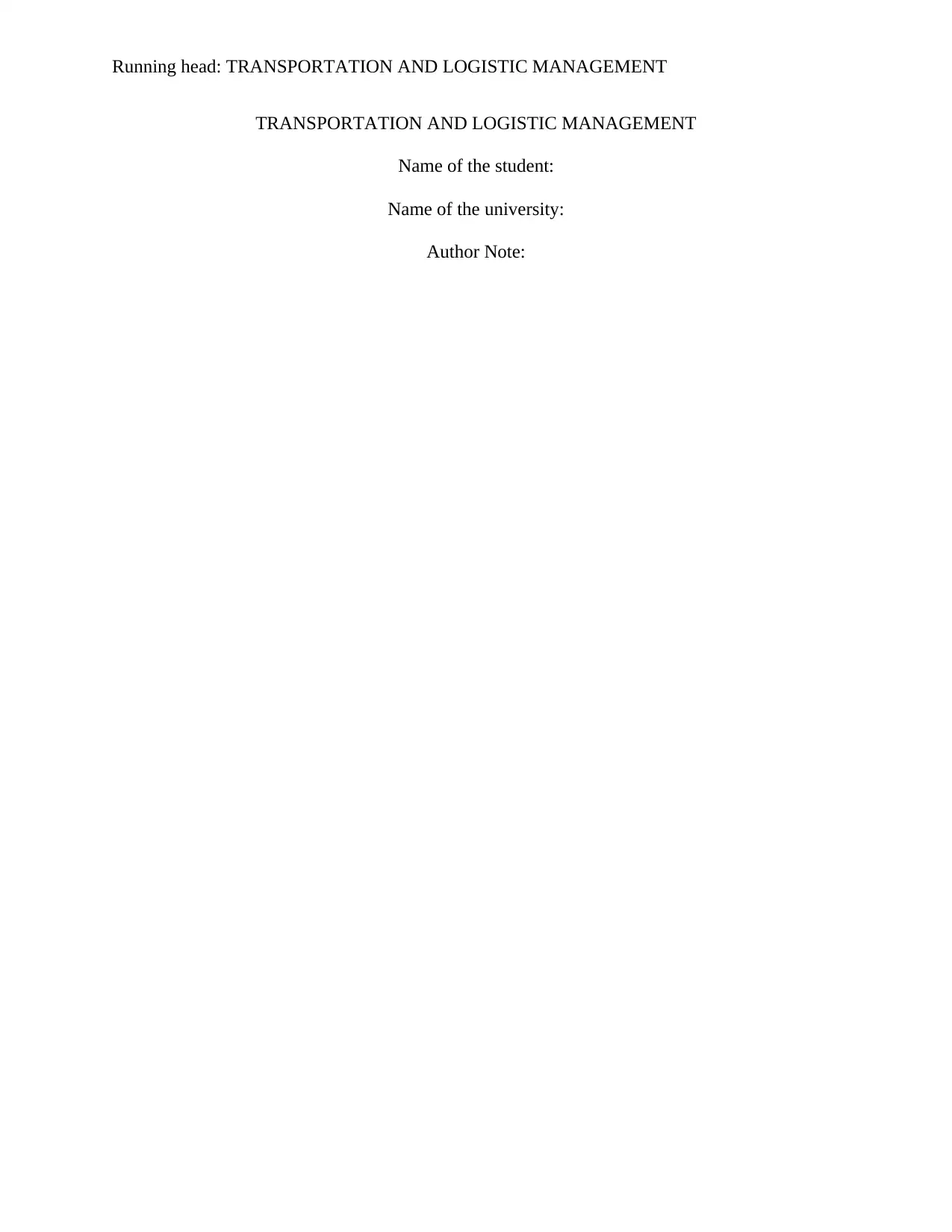
Running head: TRANSPORTATION AND LOGISTIC MANAGEMENT
TRANSPORTATION AND LOGISTIC MANAGEMENT
Name of the student:
Name of the university:
Author Note:
TRANSPORTATION AND LOGISTIC MANAGEMENT
Name of the student:
Name of the university:
Author Note:
Paraphrase This Document
Need a fresh take? Get an instant paraphrase of this document with our AI Paraphraser
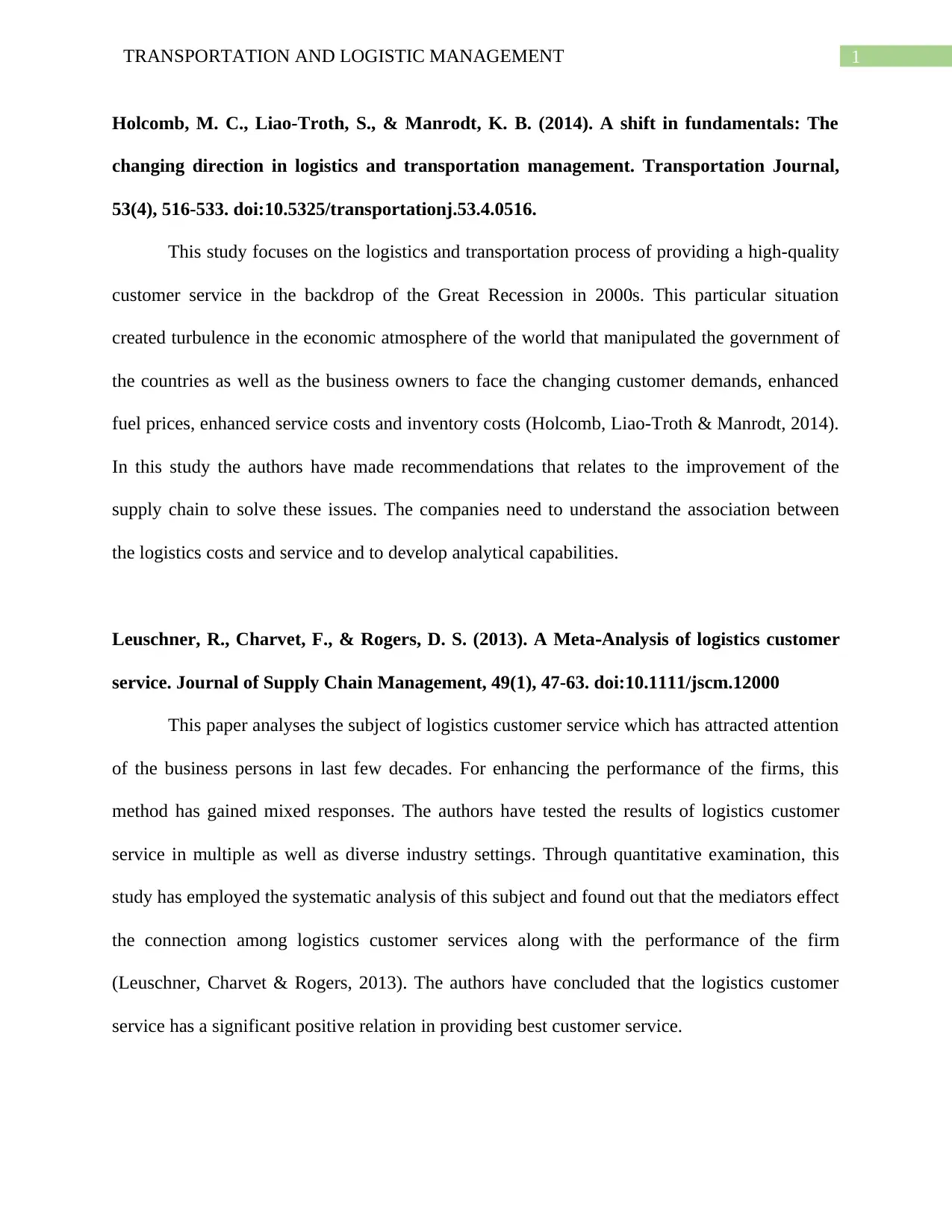
1TRANSPORTATION AND LOGISTIC MANAGEMENT
Holcomb, M. C., Liao-Troth, S., & Manrodt, K. B. (2014). A shift in fundamentals: The
changing direction in logistics and transportation management. Transportation Journal,
53(4), 516-533. doi:10.5325/transportationj.53.4.0516.
This study focuses on the logistics and transportation process of providing a high-quality
customer service in the backdrop of the Great Recession in 2000s. This particular situation
created turbulence in the economic atmosphere of the world that manipulated the government of
the countries as well as the business owners to face the changing customer demands, enhanced
fuel prices, enhanced service costs and inventory costs (Holcomb, Liao-Troth & Manrodt, 2014).
In this study the authors have made recommendations that relates to the improvement of the
supply chain to solve these issues. The companies need to understand the association between
the logistics costs and service and to develop analytical capabilities.
Leuschner, R., Charvet, F., & Rogers, D. S. (2013). A Meta‐Analysis of logistics customer
service. Journal of Supply Chain Management, 49(1), 47-63. doi:10.1111/jscm.12000
This paper analyses the subject of logistics customer service which has attracted attention
of the business persons in last few decades. For enhancing the performance of the firms, this
method has gained mixed responses. The authors have tested the results of logistics customer
service in multiple as well as diverse industry settings. Through quantitative examination, this
study has employed the systematic analysis of this subject and found out that the mediators effect
the connection among logistics customer services along with the performance of the firm
(Leuschner, Charvet & Rogers, 2013). The authors have concluded that the logistics customer
service has a significant positive relation in providing best customer service.
Holcomb, M. C., Liao-Troth, S., & Manrodt, K. B. (2014). A shift in fundamentals: The
changing direction in logistics and transportation management. Transportation Journal,
53(4), 516-533. doi:10.5325/transportationj.53.4.0516.
This study focuses on the logistics and transportation process of providing a high-quality
customer service in the backdrop of the Great Recession in 2000s. This particular situation
created turbulence in the economic atmosphere of the world that manipulated the government of
the countries as well as the business owners to face the changing customer demands, enhanced
fuel prices, enhanced service costs and inventory costs (Holcomb, Liao-Troth & Manrodt, 2014).
In this study the authors have made recommendations that relates to the improvement of the
supply chain to solve these issues. The companies need to understand the association between
the logistics costs and service and to develop analytical capabilities.
Leuschner, R., Charvet, F., & Rogers, D. S. (2013). A Meta‐Analysis of logistics customer
service. Journal of Supply Chain Management, 49(1), 47-63. doi:10.1111/jscm.12000
This paper analyses the subject of logistics customer service which has attracted attention
of the business persons in last few decades. For enhancing the performance of the firms, this
method has gained mixed responses. The authors have tested the results of logistics customer
service in multiple as well as diverse industry settings. Through quantitative examination, this
study has employed the systematic analysis of this subject and found out that the mediators effect
the connection among logistics customer services along with the performance of the firm
(Leuschner, Charvet & Rogers, 2013). The authors have concluded that the logistics customer
service has a significant positive relation in providing best customer service.
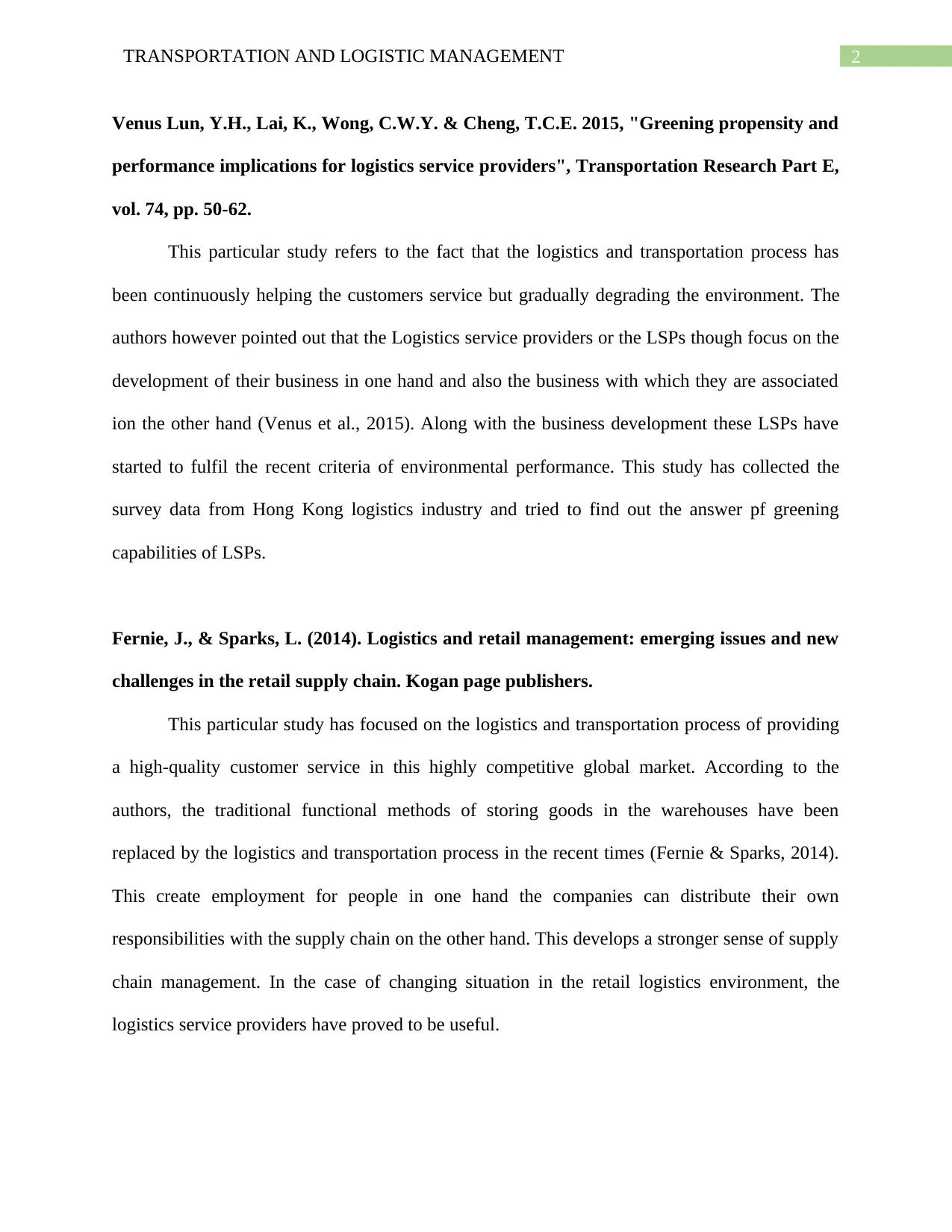
2TRANSPORTATION AND LOGISTIC MANAGEMENT
Venus Lun, Y.H., Lai, K., Wong, C.W.Y. & Cheng, T.C.E. 2015, "Greening propensity and
performance implications for logistics service providers", Transportation Research Part E,
vol. 74, pp. 50-62.
This particular study refers to the fact that the logistics and transportation process has
been continuously helping the customers service but gradually degrading the environment. The
authors however pointed out that the Logistics service providers or the LSPs though focus on the
development of their business in one hand and also the business with which they are associated
ion the other hand (Venus et al., 2015). Along with the business development these LSPs have
started to fulfil the recent criteria of environmental performance. This study has collected the
survey data from Hong Kong logistics industry and tried to find out the answer pf greening
capabilities of LSPs.
Fernie, J., & Sparks, L. (2014). Logistics and retail management: emerging issues and new
challenges in the retail supply chain. Kogan page publishers.
This particular study has focused on the logistics and transportation process of providing
a high-quality customer service in this highly competitive global market. According to the
authors, the traditional functional methods of storing goods in the warehouses have been
replaced by the logistics and transportation process in the recent times (Fernie & Sparks, 2014).
This create employment for people in one hand the companies can distribute their own
responsibilities with the supply chain on the other hand. This develops a stronger sense of supply
chain management. In the case of changing situation in the retail logistics environment, the
logistics service providers have proved to be useful.
Venus Lun, Y.H., Lai, K., Wong, C.W.Y. & Cheng, T.C.E. 2015, "Greening propensity and
performance implications for logistics service providers", Transportation Research Part E,
vol. 74, pp. 50-62.
This particular study refers to the fact that the logistics and transportation process has
been continuously helping the customers service but gradually degrading the environment. The
authors however pointed out that the Logistics service providers or the LSPs though focus on the
development of their business in one hand and also the business with which they are associated
ion the other hand (Venus et al., 2015). Along with the business development these LSPs have
started to fulfil the recent criteria of environmental performance. This study has collected the
survey data from Hong Kong logistics industry and tried to find out the answer pf greening
capabilities of LSPs.
Fernie, J., & Sparks, L. (2014). Logistics and retail management: emerging issues and new
challenges in the retail supply chain. Kogan page publishers.
This particular study has focused on the logistics and transportation process of providing
a high-quality customer service in this highly competitive global market. According to the
authors, the traditional functional methods of storing goods in the warehouses have been
replaced by the logistics and transportation process in the recent times (Fernie & Sparks, 2014).
This create employment for people in one hand the companies can distribute their own
responsibilities with the supply chain on the other hand. This develops a stronger sense of supply
chain management. In the case of changing situation in the retail logistics environment, the
logistics service providers have proved to be useful.
⊘ This is a preview!⊘
Do you want full access?
Subscribe today to unlock all pages.

Trusted by 1+ million students worldwide
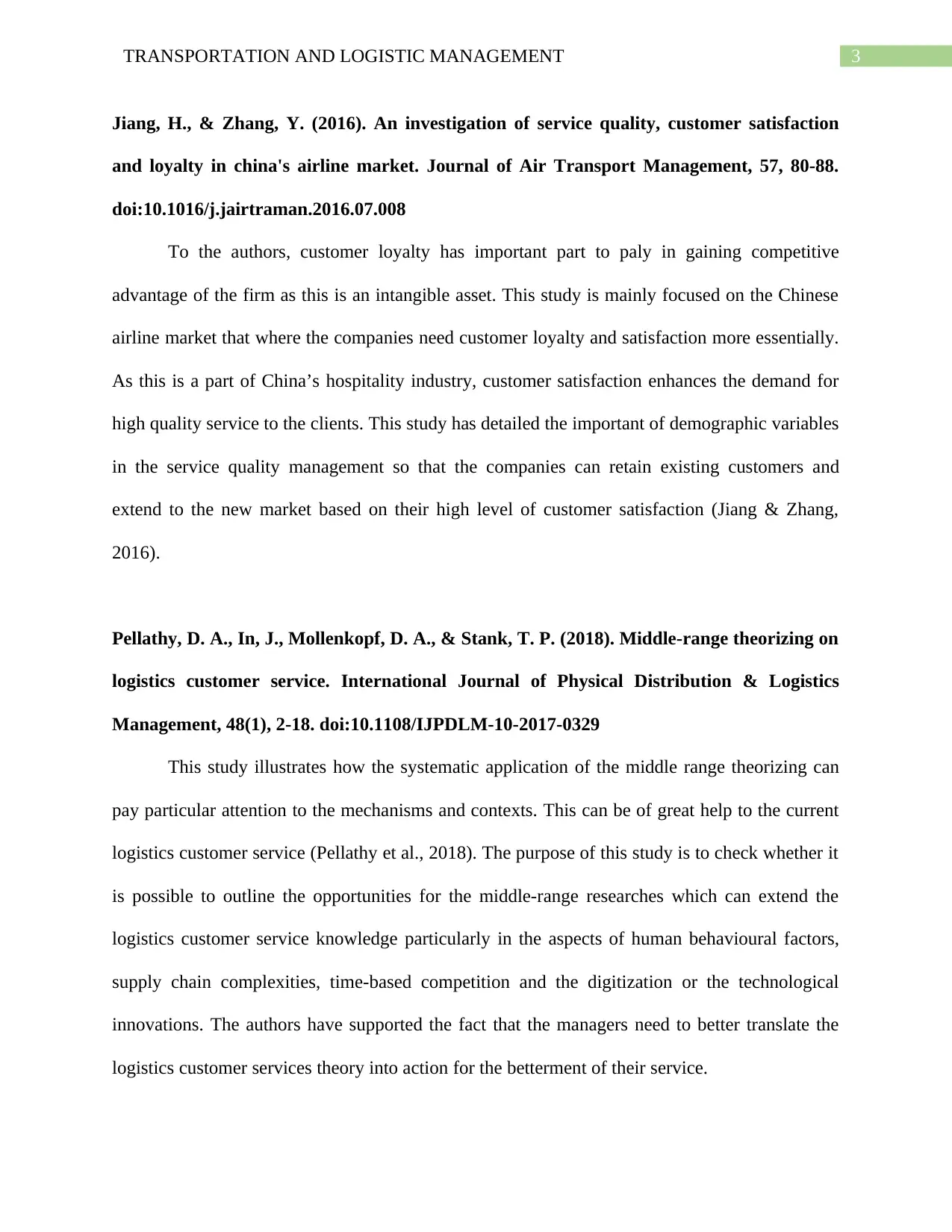
3TRANSPORTATION AND LOGISTIC MANAGEMENT
Jiang, H., & Zhang, Y. (2016). An investigation of service quality, customer satisfaction
and loyalty in china's airline market. Journal of Air Transport Management, 57, 80-88.
doi:10.1016/j.jairtraman.2016.07.008
To the authors, customer loyalty has important part to paly in gaining competitive
advantage of the firm as this is an intangible asset. This study is mainly focused on the Chinese
airline market that where the companies need customer loyalty and satisfaction more essentially.
As this is a part of China’s hospitality industry, customer satisfaction enhances the demand for
high quality service to the clients. This study has detailed the important of demographic variables
in the service quality management so that the companies can retain existing customers and
extend to the new market based on their high level of customer satisfaction (Jiang & Zhang,
2016).
Pellathy, D. A., In, J., Mollenkopf, D. A., & Stank, T. P. (2018). Middle-range theorizing on
logistics customer service. International Journal of Physical Distribution & Logistics
Management, 48(1), 2-18. doi:10.1108/IJPDLM-10-2017-0329
This study illustrates how the systematic application of the middle range theorizing can
pay particular attention to the mechanisms and contexts. This can be of great help to the current
logistics customer service (Pellathy et al., 2018). The purpose of this study is to check whether it
is possible to outline the opportunities for the middle-range researches which can extend the
logistics customer service knowledge particularly in the aspects of human behavioural factors,
supply chain complexities, time-based competition and the digitization or the technological
innovations. The authors have supported the fact that the managers need to better translate the
logistics customer services theory into action for the betterment of their service.
Jiang, H., & Zhang, Y. (2016). An investigation of service quality, customer satisfaction
and loyalty in china's airline market. Journal of Air Transport Management, 57, 80-88.
doi:10.1016/j.jairtraman.2016.07.008
To the authors, customer loyalty has important part to paly in gaining competitive
advantage of the firm as this is an intangible asset. This study is mainly focused on the Chinese
airline market that where the companies need customer loyalty and satisfaction more essentially.
As this is a part of China’s hospitality industry, customer satisfaction enhances the demand for
high quality service to the clients. This study has detailed the important of demographic variables
in the service quality management so that the companies can retain existing customers and
extend to the new market based on their high level of customer satisfaction (Jiang & Zhang,
2016).
Pellathy, D. A., In, J., Mollenkopf, D. A., & Stank, T. P. (2018). Middle-range theorizing on
logistics customer service. International Journal of Physical Distribution & Logistics
Management, 48(1), 2-18. doi:10.1108/IJPDLM-10-2017-0329
This study illustrates how the systematic application of the middle range theorizing can
pay particular attention to the mechanisms and contexts. This can be of great help to the current
logistics customer service (Pellathy et al., 2018). The purpose of this study is to check whether it
is possible to outline the opportunities for the middle-range researches which can extend the
logistics customer service knowledge particularly in the aspects of human behavioural factors,
supply chain complexities, time-based competition and the digitization or the technological
innovations. The authors have supported the fact that the managers need to better translate the
logistics customer services theory into action for the betterment of their service.
Paraphrase This Document
Need a fresh take? Get an instant paraphrase of this document with our AI Paraphraser
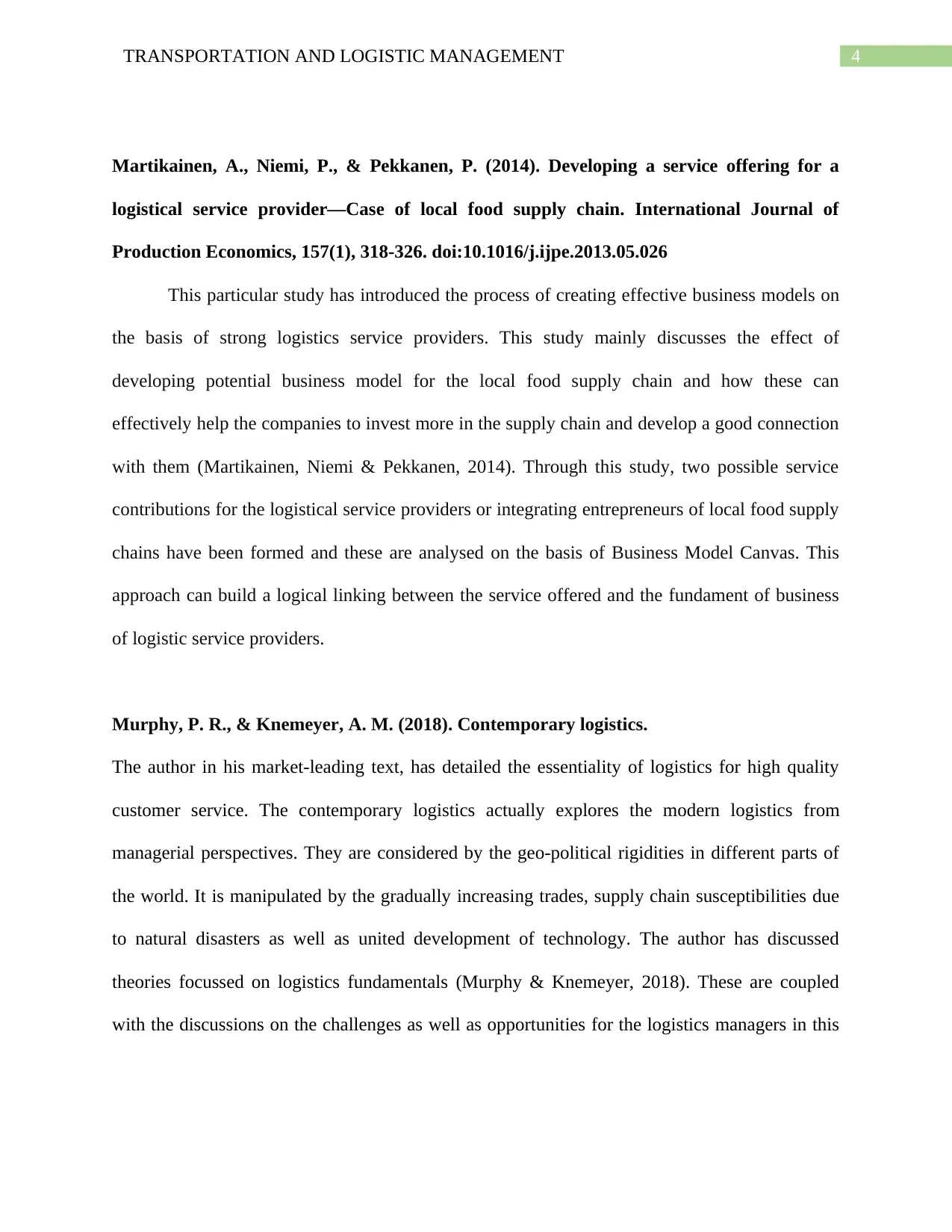
4TRANSPORTATION AND LOGISTIC MANAGEMENT
Martikainen, A., Niemi, P., & Pekkanen, P. (2014). Developing a service offering for a
logistical service provider—Case of local food supply chain. International Journal of
Production Economics, 157(1), 318-326. doi:10.1016/j.ijpe.2013.05.026
This particular study has introduced the process of creating effective business models on
the basis of strong logistics service providers. This study mainly discusses the effect of
developing potential business model for the local food supply chain and how these can
effectively help the companies to invest more in the supply chain and develop a good connection
with them (Martikainen, Niemi & Pekkanen, 2014). Through this study, two possible service
contributions for the logistical service providers or integrating entrepreneurs of local food supply
chains have been formed and these are analysed on the basis of Business Model Canvas. This
approach can build a logical linking between the service offered and the fundament of business
of logistic service providers.
Murphy, P. R., & Knemeyer, A. M. (2018). Contemporary logistics.
The author in his market-leading text, has detailed the essentiality of logistics for high quality
customer service. The contemporary logistics actually explores the modern logistics from
managerial perspectives. They are considered by the geo-political rigidities in different parts of
the world. It is manipulated by the gradually increasing trades, supply chain susceptibilities due
to natural disasters as well as united development of technology. The author has discussed
theories focussed on logistics fundamentals (Murphy & Knemeyer, 2018). These are coupled
with the discussions on the challenges as well as opportunities for the logistics managers in this
Martikainen, A., Niemi, P., & Pekkanen, P. (2014). Developing a service offering for a
logistical service provider—Case of local food supply chain. International Journal of
Production Economics, 157(1), 318-326. doi:10.1016/j.ijpe.2013.05.026
This particular study has introduced the process of creating effective business models on
the basis of strong logistics service providers. This study mainly discusses the effect of
developing potential business model for the local food supply chain and how these can
effectively help the companies to invest more in the supply chain and develop a good connection
with them (Martikainen, Niemi & Pekkanen, 2014). Through this study, two possible service
contributions for the logistical service providers or integrating entrepreneurs of local food supply
chains have been formed and these are analysed on the basis of Business Model Canvas. This
approach can build a logical linking between the service offered and the fundament of business
of logistic service providers.
Murphy, P. R., & Knemeyer, A. M. (2018). Contemporary logistics.
The author in his market-leading text, has detailed the essentiality of logistics for high quality
customer service. The contemporary logistics actually explores the modern logistics from
managerial perspectives. They are considered by the geo-political rigidities in different parts of
the world. It is manipulated by the gradually increasing trades, supply chain susceptibilities due
to natural disasters as well as united development of technology. The author has discussed
theories focussed on logistics fundamentals (Murphy & Knemeyer, 2018). These are coupled
with the discussions on the challenges as well as opportunities for the logistics managers in this
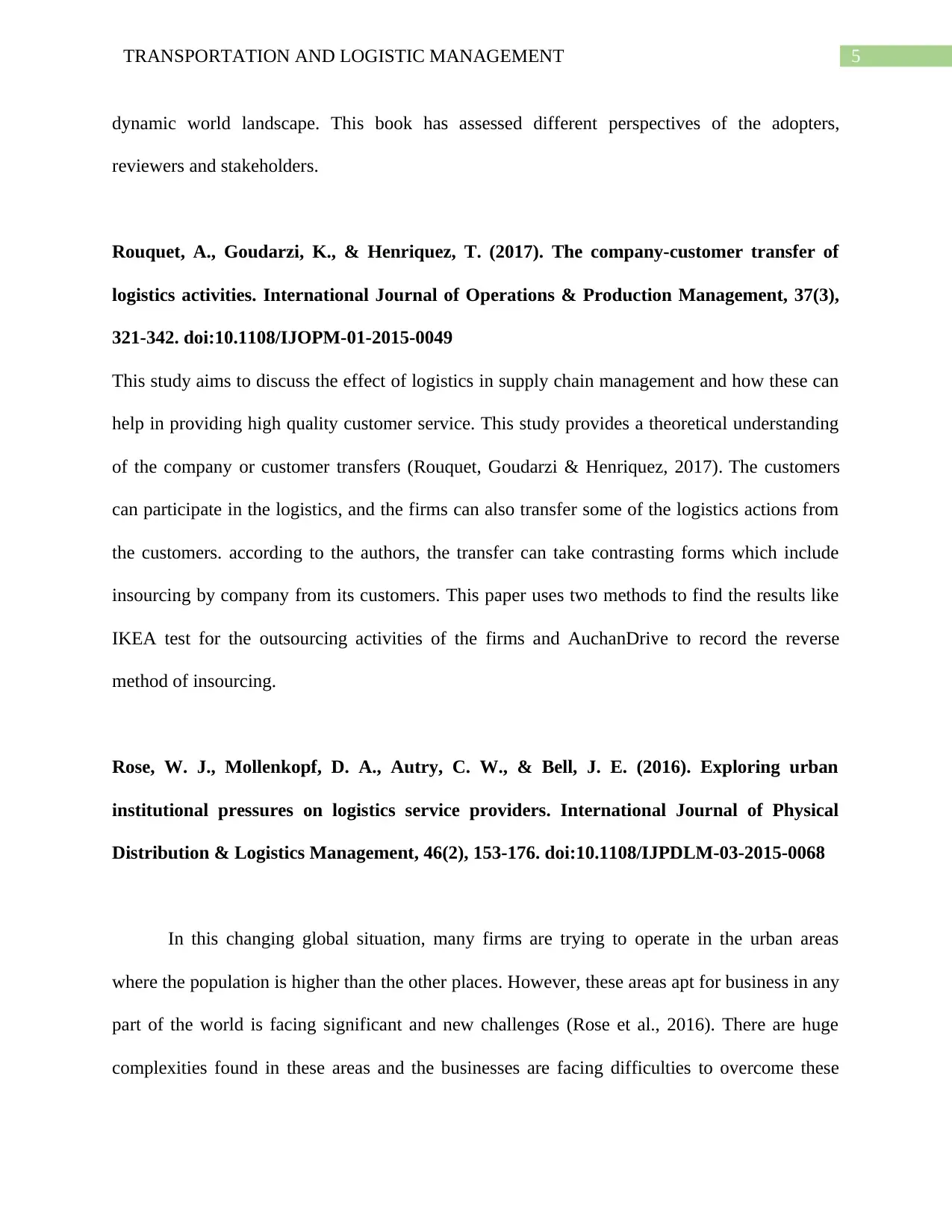
5TRANSPORTATION AND LOGISTIC MANAGEMENT
dynamic world landscape. This book has assessed different perspectives of the adopters,
reviewers and stakeholders.
Rouquet, A., Goudarzi, K., & Henriquez, T. (2017). The company-customer transfer of
logistics activities. International Journal of Operations & Production Management, 37(3),
321-342. doi:10.1108/IJOPM-01-2015-0049
This study aims to discuss the effect of logistics in supply chain management and how these can
help in providing high quality customer service. This study provides a theoretical understanding
of the company or customer transfers (Rouquet, Goudarzi & Henriquez, 2017). The customers
can participate in the logistics, and the firms can also transfer some of the logistics actions from
the customers. according to the authors, the transfer can take contrasting forms which include
insourcing by company from its customers. This paper uses two methods to find the results like
IKEA test for the outsourcing activities of the firms and AuchanDrive to record the reverse
method of insourcing.
Rose, W. J., Mollenkopf, D. A., Autry, C. W., & Bell, J. E. (2016). Exploring urban
institutional pressures on logistics service providers. International Journal of Physical
Distribution & Logistics Management, 46(2), 153-176. doi:10.1108/IJPDLM-03-2015-0068
In this changing global situation, many firms are trying to operate in the urban areas
where the population is higher than the other places. However, these areas apt for business in any
part of the world is facing significant and new challenges (Rose et al., 2016). There are huge
complexities found in these areas and the businesses are facing difficulties to overcome these
dynamic world landscape. This book has assessed different perspectives of the adopters,
reviewers and stakeholders.
Rouquet, A., Goudarzi, K., & Henriquez, T. (2017). The company-customer transfer of
logistics activities. International Journal of Operations & Production Management, 37(3),
321-342. doi:10.1108/IJOPM-01-2015-0049
This study aims to discuss the effect of logistics in supply chain management and how these can
help in providing high quality customer service. This study provides a theoretical understanding
of the company or customer transfers (Rouquet, Goudarzi & Henriquez, 2017). The customers
can participate in the logistics, and the firms can also transfer some of the logistics actions from
the customers. according to the authors, the transfer can take contrasting forms which include
insourcing by company from its customers. This paper uses two methods to find the results like
IKEA test for the outsourcing activities of the firms and AuchanDrive to record the reverse
method of insourcing.
Rose, W. J., Mollenkopf, D. A., Autry, C. W., & Bell, J. E. (2016). Exploring urban
institutional pressures on logistics service providers. International Journal of Physical
Distribution & Logistics Management, 46(2), 153-176. doi:10.1108/IJPDLM-03-2015-0068
In this changing global situation, many firms are trying to operate in the urban areas
where the population is higher than the other places. However, these areas apt for business in any
part of the world is facing significant and new challenges (Rose et al., 2016). There are huge
complexities found in these areas and the businesses are facing difficulties to overcome these
⊘ This is a preview!⊘
Do you want full access?
Subscribe today to unlock all pages.

Trusted by 1+ million students worldwide
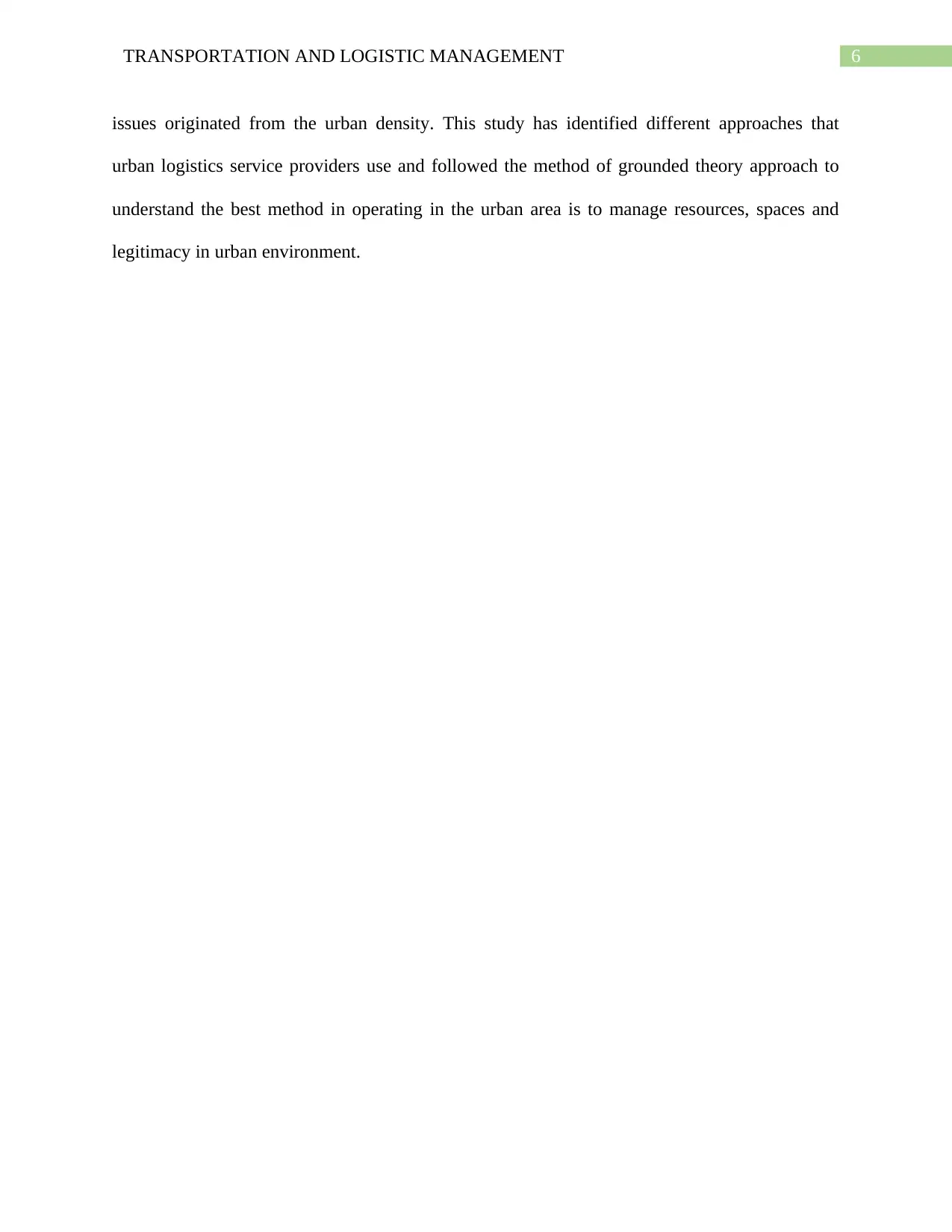
6TRANSPORTATION AND LOGISTIC MANAGEMENT
issues originated from the urban density. This study has identified different approaches that
urban logistics service providers use and followed the method of grounded theory approach to
understand the best method in operating in the urban area is to manage resources, spaces and
legitimacy in urban environment.
issues originated from the urban density. This study has identified different approaches that
urban logistics service providers use and followed the method of grounded theory approach to
understand the best method in operating in the urban area is to manage resources, spaces and
legitimacy in urban environment.
Paraphrase This Document
Need a fresh take? Get an instant paraphrase of this document with our AI Paraphraser
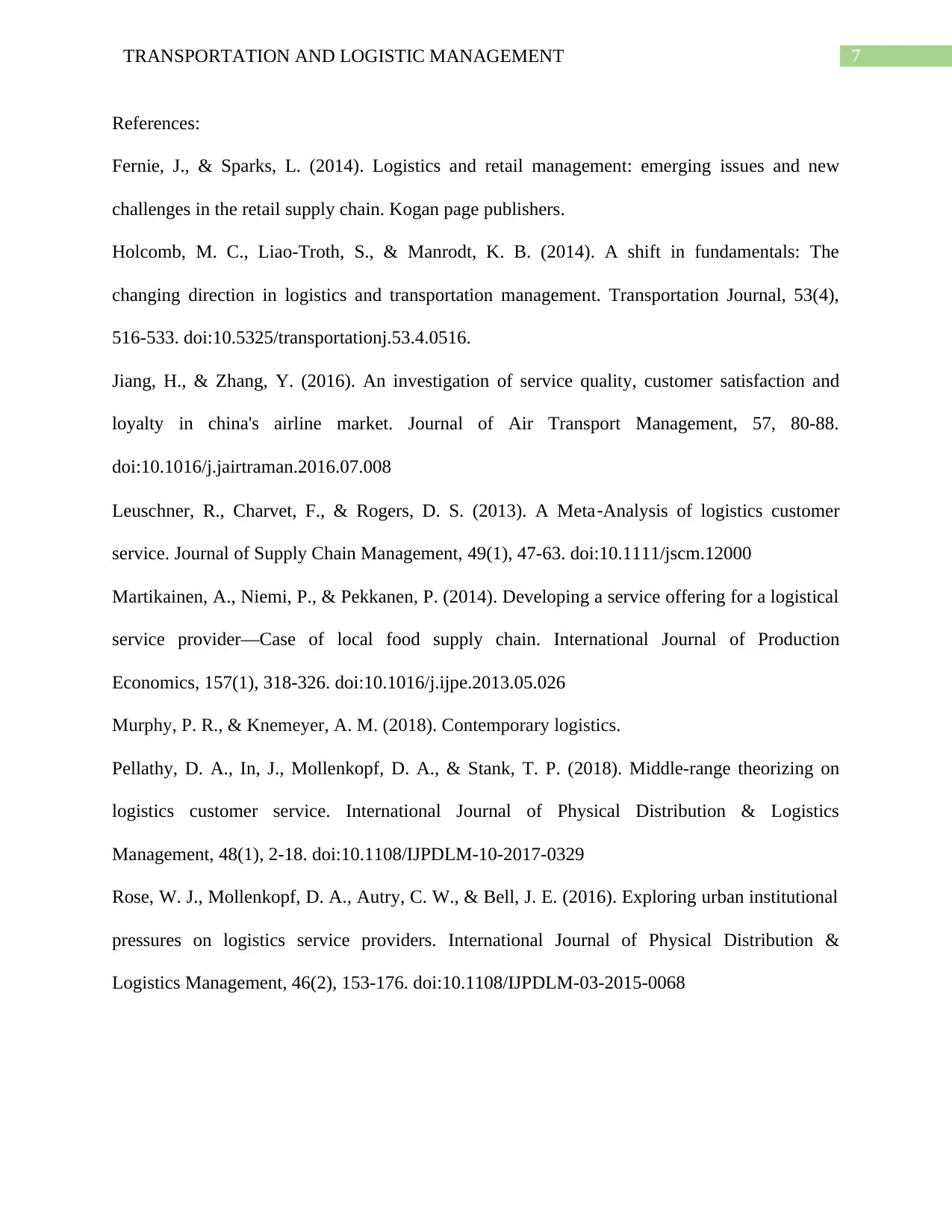
7TRANSPORTATION AND LOGISTIC MANAGEMENT
References:
Fernie, J., & Sparks, L. (2014). Logistics and retail management: emerging issues and new
challenges in the retail supply chain. Kogan page publishers.
Holcomb, M. C., Liao-Troth, S., & Manrodt, K. B. (2014). A shift in fundamentals: The
changing direction in logistics and transportation management. Transportation Journal, 53(4),
516-533. doi:10.5325/transportationj.53.4.0516.
Jiang, H., & Zhang, Y. (2016). An investigation of service quality, customer satisfaction and
loyalty in china's airline market. Journal of Air Transport Management, 57, 80-88.
doi:10.1016/j.jairtraman.2016.07.008
Leuschner, R., Charvet, F., & Rogers, D. S. (2013). A Meta‐Analysis of logistics customer
service. Journal of Supply Chain Management, 49(1), 47-63. doi:10.1111/jscm.12000
Martikainen, A., Niemi, P., & Pekkanen, P. (2014). Developing a service offering for a logistical
service provider—Case of local food supply chain. International Journal of Production
Economics, 157(1), 318-326. doi:10.1016/j.ijpe.2013.05.026
Murphy, P. R., & Knemeyer, A. M. (2018). Contemporary logistics.
Pellathy, D. A., In, J., Mollenkopf, D. A., & Stank, T. P. (2018). Middle-range theorizing on
logistics customer service. International Journal of Physical Distribution & Logistics
Management, 48(1), 2-18. doi:10.1108/IJPDLM-10-2017-0329
Rose, W. J., Mollenkopf, D. A., Autry, C. W., & Bell, J. E. (2016). Exploring urban institutional
pressures on logistics service providers. International Journal of Physical Distribution &
Logistics Management, 46(2), 153-176. doi:10.1108/IJPDLM-03-2015-0068
References:
Fernie, J., & Sparks, L. (2014). Logistics and retail management: emerging issues and new
challenges in the retail supply chain. Kogan page publishers.
Holcomb, M. C., Liao-Troth, S., & Manrodt, K. B. (2014). A shift in fundamentals: The
changing direction in logistics and transportation management. Transportation Journal, 53(4),
516-533. doi:10.5325/transportationj.53.4.0516.
Jiang, H., & Zhang, Y. (2016). An investigation of service quality, customer satisfaction and
loyalty in china's airline market. Journal of Air Transport Management, 57, 80-88.
doi:10.1016/j.jairtraman.2016.07.008
Leuschner, R., Charvet, F., & Rogers, D. S. (2013). A Meta‐Analysis of logistics customer
service. Journal of Supply Chain Management, 49(1), 47-63. doi:10.1111/jscm.12000
Martikainen, A., Niemi, P., & Pekkanen, P. (2014). Developing a service offering for a logistical
service provider—Case of local food supply chain. International Journal of Production
Economics, 157(1), 318-326. doi:10.1016/j.ijpe.2013.05.026
Murphy, P. R., & Knemeyer, A. M. (2018). Contemporary logistics.
Pellathy, D. A., In, J., Mollenkopf, D. A., & Stank, T. P. (2018). Middle-range theorizing on
logistics customer service. International Journal of Physical Distribution & Logistics
Management, 48(1), 2-18. doi:10.1108/IJPDLM-10-2017-0329
Rose, W. J., Mollenkopf, D. A., Autry, C. W., & Bell, J. E. (2016). Exploring urban institutional
pressures on logistics service providers. International Journal of Physical Distribution &
Logistics Management, 46(2), 153-176. doi:10.1108/IJPDLM-03-2015-0068
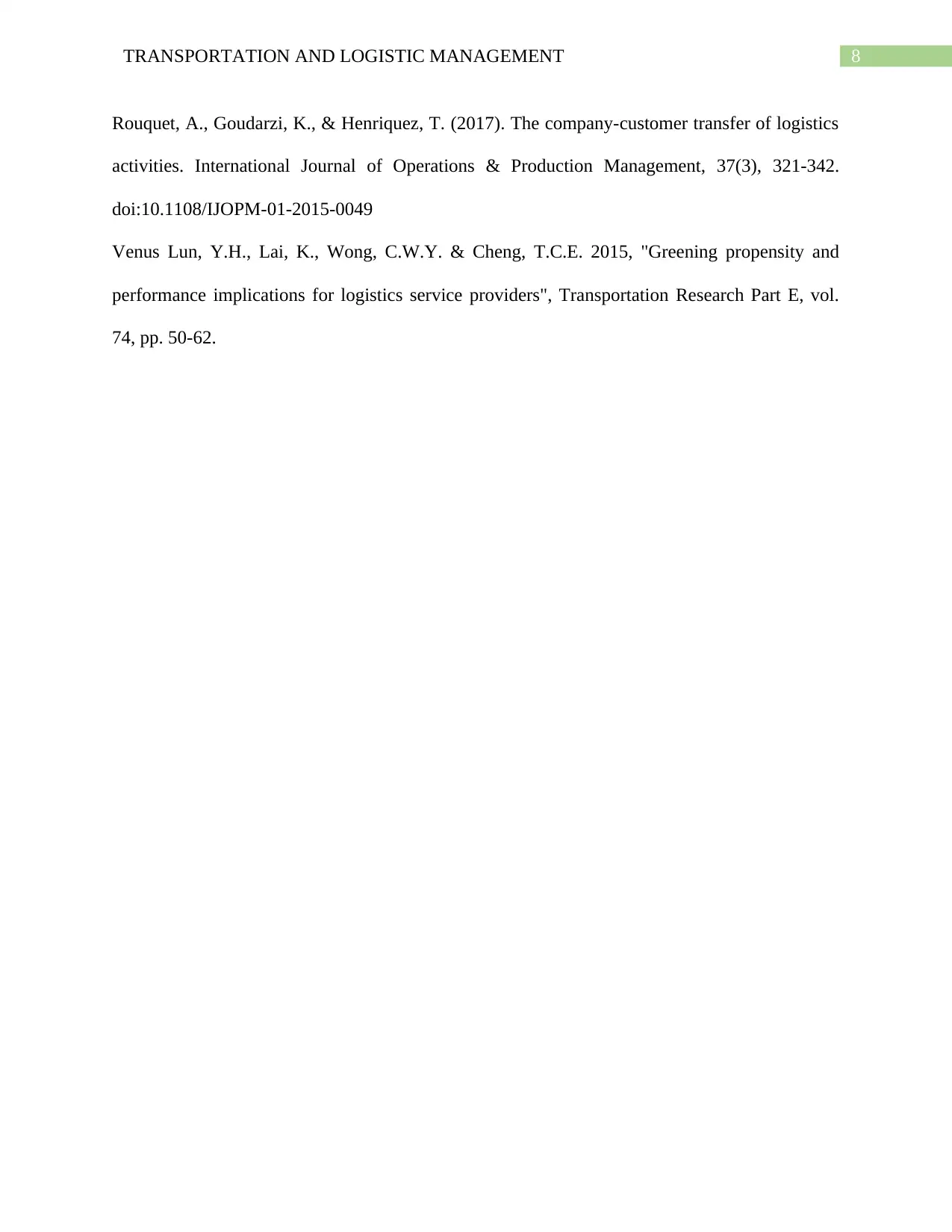
8TRANSPORTATION AND LOGISTIC MANAGEMENT
Rouquet, A., Goudarzi, K., & Henriquez, T. (2017). The company-customer transfer of logistics
activities. International Journal of Operations & Production Management, 37(3), 321-342.
doi:10.1108/IJOPM-01-2015-0049
Venus Lun, Y.H., Lai, K., Wong, C.W.Y. & Cheng, T.C.E. 2015, "Greening propensity and
performance implications for logistics service providers", Transportation Research Part E, vol.
74, pp. 50-62.
Rouquet, A., Goudarzi, K., & Henriquez, T. (2017). The company-customer transfer of logistics
activities. International Journal of Operations & Production Management, 37(3), 321-342.
doi:10.1108/IJOPM-01-2015-0049
Venus Lun, Y.H., Lai, K., Wong, C.W.Y. & Cheng, T.C.E. 2015, "Greening propensity and
performance implications for logistics service providers", Transportation Research Part E, vol.
74, pp. 50-62.
⊘ This is a preview!⊘
Do you want full access?
Subscribe today to unlock all pages.

Trusted by 1+ million students worldwide
1 out of 9
Related Documents
Your All-in-One AI-Powered Toolkit for Academic Success.
+13062052269
info@desklib.com
Available 24*7 on WhatsApp / Email
![[object Object]](/_next/static/media/star-bottom.7253800d.svg)
Unlock your academic potential
Copyright © 2020–2025 A2Z Services. All Rights Reserved. Developed and managed by ZUCOL.





